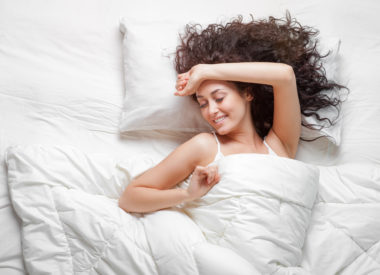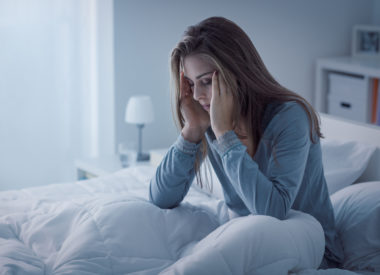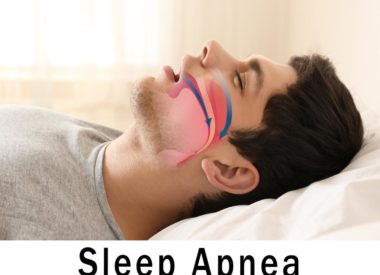What is REM sleep?
This unique cycle in our sleep architecture has a form and function distinct among the other nonREM stages of sleep.
We cycle through all the stages of sleep in a progression from the beginning (stage 1 nonREM) to the end (REM sleep) several times over the course of the night (see the chart below).
Adults spend between 20 and 25 percent of the night in REM sleep, while infants spend nearly half their sleep time in this stage.
In fact, it was while measuring the eye patterns of sleeping infants that REM sleep was first discovered.
What is stage REM sleep?
Rapid-eye movement sleep is distinguished from nonREM sleep in a number of ways.
-
Almost all the muscles of the body (save for certain eye muscles, the heart, and the diaphragm) fall into a paralysis upon the onset of REM sleep
-
The eyes, while still closed, dart up and down, or left and right, in patterns distinguishable from other sleep stages on an electrooculogram
-
The brain becomes more active as indicated by electroencephalogram (EEG) patterns, with waveforms similar to those while awake
-
While body temperature slowly declines following sleep onset, in stage REM sleep, the body reaches its lowest core temperature
-
Pulse and respiratory rate, slower in non-REM sleep, become variable
-
Blood pressure increases
-
This is the stage in which most dreaming occurs (exception: Night terrors only take place during nonREM sleep)
The first REM sleep stage takes place around 90 minutes following sleep onset.
Each stage of REM encountered in the early evening is shorter in length, as the first third of the night is mostly spent in stages 2 and 3 (nonREM).
In the second and final thirds of the night, REM repeats in longer and longer sequences.
Why is stage REM sleep different from nonREM sleep?
The stage REM sleep cycles obvious distinguishing factor is its notorious eye movements.These can occur either as constant (tonic) patterns or intermittently (aphasic patterns). Researchers believe these eye movements correspond to internal visual imagery attached to dreams occurring during stage REM sleep, especially during brain wave spikes that occur in areas of the brain also involved in vision.
REM sleep, because of its highly active nature, has been nicknamed paradoxical sleep.
Dreams are theorized to play a big part in the drive to achieve REM. We spend more than 2 hours each night dreaming, though scientists still haven’t unraveled the mystery as to why.
REM sleep stimulates learning and consolidation of memory as opposed to the healing and restorative functions that take place at the cellular level during deep nonREM sleep.
REM sleep and sleep disorders
Alterations in the mechanisms that signal REM sleep may lead to problems with sleep.
REM behavior disorder
When the brain shifts from nonREM sleep to REM,
a process takes place which shuts down signals to the muscular system, leading to an intentional, temporary paralysis.
However, if the brain fails to block these signals to the muscles, people may physically act out dreams in a rare, dangerous sleep condition called REM behavior disorder (RBD).
The biographical film, Sleepwalk With Me, featuring comic Mike Birbiglia, details his real-life struggle with RBD and demonstrates what could happen if its left untreated.
Narcolepsy
The key symptoms of narcolepsy cataplexy, hallucinations, sleep paralysis, and excessive daytime sleepiness are considered by some sleep researchers to be features of REM sleep which occur during periods of wakefulness.
People with narcolepsy also experience disruptive sleep at night. They may not take 90 minutes to launch into REM sleep; rather, they often achieve it in less than 10 minutes after falling asleep, in episodes called sleep onset REM periods (SOREMPs).
Sleep deprivation
Any time a person does not achieve adequate sleep, they risk losing out on adequate REM sleep. When the brain does not get enough REM sleep, it begins to lose its ability to process and consolidate memory, and cognitive functions during daytime can suffer.
REM rebound
If a person is sleep deprived (for whatever reason), then given the right conditions and opportunity to sleep fully, they might experience what is calledREM rebound.REM rebound effect occurs when the brain, during nonREM sleep, launches quickly to REM stage sleep to make up for lost REM.
While making up for lost REM is a good thing, the physiological changes that REM sets into motion may be problematic for some. For instance, a person with hypertension will have an elevated blood pressure for longer periods during REM rebound.
What suppresses REM sleep?
Getting enough REM sleep is a healthy goal, but sometimes there are barriers to this critical part of the sleep architecture:
Sleep disorders:Insomnia, circadian rhythm disorders, or sleep apnea all have the potential to cause sleep to become fragmented all night long. This can prevent healthy periods of REM from taking place.
Medical conditions:Any symptom of a medical condition that can disrupt sleep such as pain from arthritis, blood sugar imbalances from diabetes, or breathing problems from asthma can fragment sleep architecture and suppress the REM cycle.
Drugs:Antidepressants are known to suppress REM sleep. People who use tobacco, marijuana, or alcohol can also expect to be shortchanged quality REM sleep, as well as the deeper stage 3 nonREM sleep they need, which is restorative and healing.
What happens if I don’t get enough REM sleep?
A lack of REM sleep can lead to a host of daytime problems.
-
Animal studies show that rats (which normally live up to 3 years) survive only 5 weeks if they are deprived of REM. They also develop unhealthy low core temperatures and show evidence of impaired immune systems.
-
Without adequate REM, certain neurological processes cannot shut down at the cellular level to self-correct; they can become depleted or polluted by biological byproducts, leading to dysfunction. Without REM to help “clean out” the brain, you might suffer from daytime problems with focus, impaired memory, even hallucinations and mood swings as a result.
-
Your brain needs REM sleep to process new learning and to make sense of new information (potentially through the narrative of dreaming). One study showed that when people were taught a complex new task, they did not adequately remember what they had learned if they were deprived of REM sleep afterward.
Sleep researchers continue to puzzle over the relationship between REM and nonREM stages of sleep, but what they do know is this: we need REM sleep to be fully functional human beings, and our brains, when deprived of adequate rapid-eye movement sleep, will do whatevers needed to reclaim it at any given opportunity.
Sources:
American Sleep Association
Healthy Sleep (Harvard)
How Sleep Works
National Sleep Foundation
The Promise of Sleep by William C. Dement MD PhD



